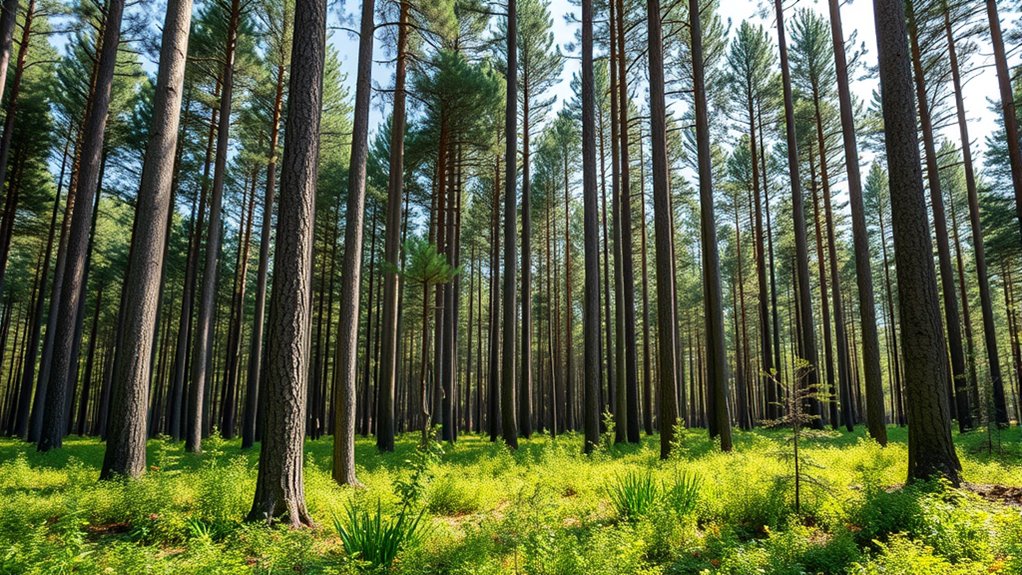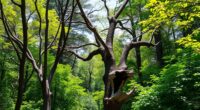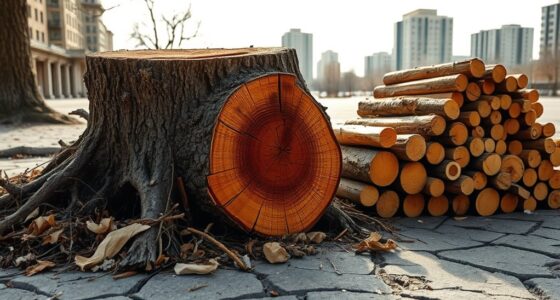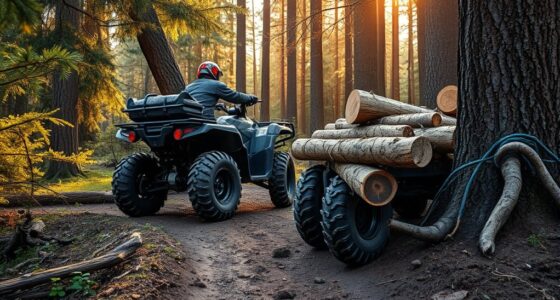Timber Stand Improvement (TSI) involves selecting healthy, desirable trees with strong growth and good form, then managing competition by thinning crowded or unhealthy trees. You also control unwanted vegetation and invasive species through appropriate methods like herbicides, ensuring the stand stays balanced and vigorous. Regular monitoring helps you evaluate progress and make adjustments for healthier, more productive forests. Keep exploring, and you’ll discover strategies to optimize your stand’s health and timber value.
Key Takeaways
- TSI aims to enhance tree health, growth, and timber quality through selective management practices.
- Selecting desirable trees involves assessing vigor, form, and genetic traits for optimal growth potential.
- Managing competition includes thinning overcrowded stands and removing unhealthy or suppressed trees.
- Proper use of herbicides, soil improvements, and water management supports stand productivity and ecological balance.
- Regular monitoring and evaluation ensure sustainable stand health, resilience, and adaptation over time.
Understanding the Goals of TSI
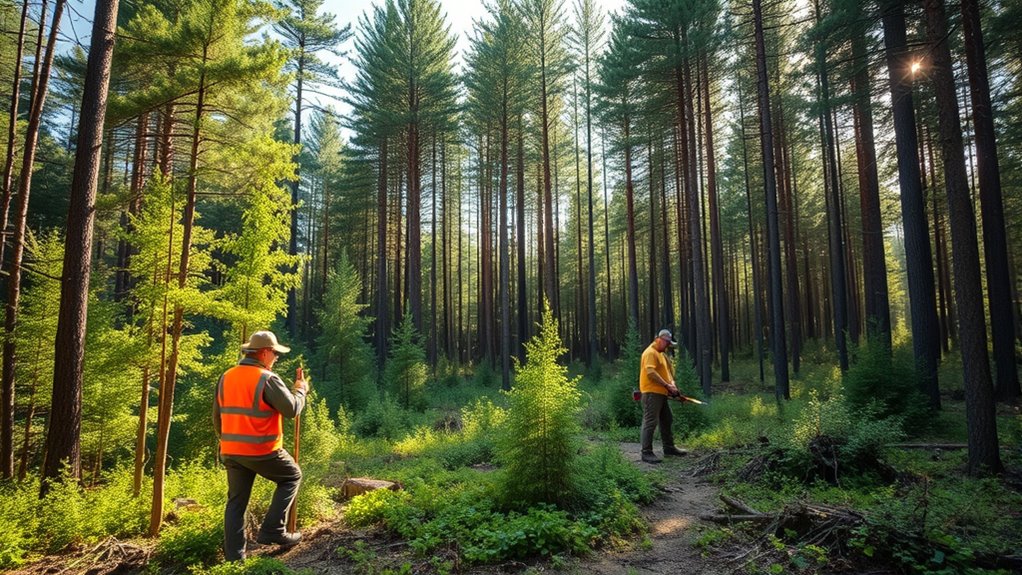
Understanding the goals of Timber Stand Improvement (TSI) is essential for effectively managing your forest. TSI aims to enhance forest genetics, ensuring trees grow stronger, healthier, and more valuable over time. By selecting and promoting superior trees, you can improve the genetic quality of your stand, leading to better timber production and increased timber valuation. TSI also helps manage stand density, reduce competition, and promote species diversity, all contributing to a more resilient forest. These practices maximize growth rates and timber quality, which directly impacts your economic returns. Ultimately, your goal is to create a stand that is sustainable, productive, and profitable, aligning forest health with timber valuation. Incorporating Cultural Intelligence principles can further improve your ability to adapt management strategies across diverse forest environments. Understanding these core objectives guides your management decisions and supports long-term forest productivity.
Identifying and Selecting Desirable Trees
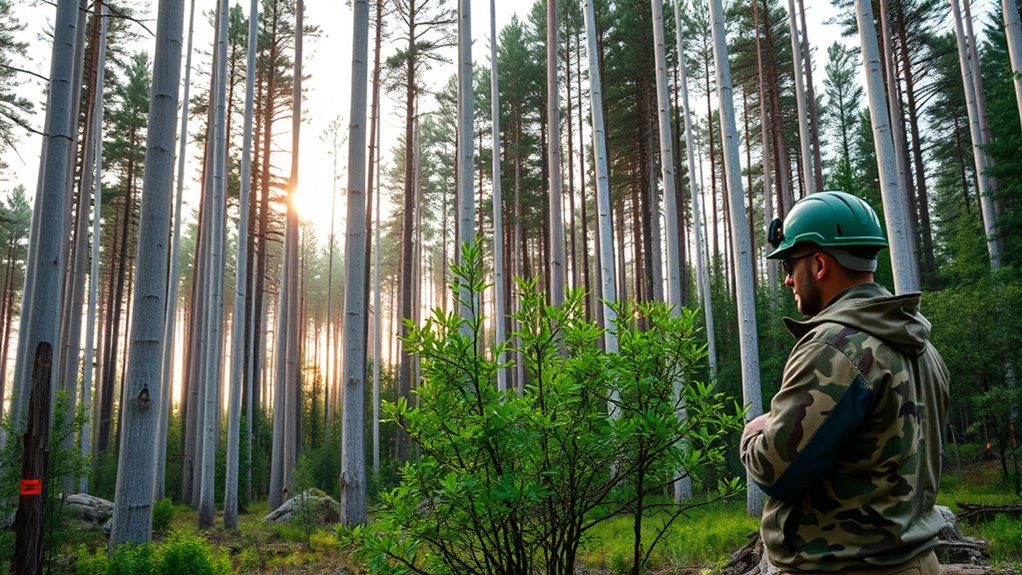
To improve your stand, you need to spot healthy trees that show strong growth and good form. Focus on selecting quality specimens that will produce valuable timber over time. Creativity in selection involves observing not only the current health but also the potential for growth and adaptability, thus setting a solid foundation for successful stand improvement. Additionally, utilizing vetted survival techniques can aid in understanding how different trees respond to environmental changes, ensuring the longevity and productivity of your stand. Recognizing the importance of tree size and spacing can help optimize growth conditions and overall stand health. Incorporating diverse designs in assessing tree health can provide a more comprehensive understanding of your stand’s overall vitality and resilience. Understanding digital literacy can enhance your ability to analyze and interpret data related to tree health and environmental conditions.
Recognizing Healthy Trees
When selecting healthy trees for timber stand improvement, it’s essential to look for signs of vigor and good overall condition. First, examine the foliage for uniform color and absence of disease signs like spots or discoloration. Second, check the bark for damage, cracks, or signs of pests. Third, assess root health by gently inspecting the base for swelling or decay, which can indicate root issues. Fourth, observe the overall structure: healthy trees have straight trunks, strong branches, and a balanced form. Additionally, nutritional benefits of the trees, such as adequate mineral content, can influence their growth potential. Recognizing these indicators helps you select trees with the best potential for growth and timber quality, ensuring a healthier, more productive stand. Additionally, understanding the importance of tree vigor can guide you in choosing the most suitable trees for improvement efforts. Moreover, monitoring stand conditions regularly can help detect early signs of decline, allowing for timely management actions. Being aware of market trends can also influence which trees are prioritized for improvement based on future economic value. Paying attention to growth rate is also crucial, as faster-growing trees tend to yield higher-quality timber over time.
Choosing Quality Specimens
Selecting the best trees for timber stand improvement involves more than just identifying healthy ones; it requires pinpointing those with superior genetic qualities and growth potential. To do this effectively, you need to assess each tree’s timber valuation, considering factors like form, vigor, and species. Tree marking helps you distinguish desirable specimens from less promising ones, ensuring you focus on the most valuable trees. Look for straight trunks, well-formed branches, and strong growth habits that indicate high-quality timber. By carefully selecting and marking these specimens, you promote the development of a stand that produces superior wood and maximizes your timber value over time. Understanding the effectiveness of eye patches can be a useful analogy for evaluating how well your selection practices might improve the stand, as consistent use of good criteria leads to better results. This strategic approach ensures you invest in the best genetic material for future growth and productivity. Additionally, recognizing the importance of tree form can help you identify trees with the structural qualities necessary for high-quality timber and long-term stand health. Evaluating growth patterns can further assist in selecting trees that will develop optimal timber characteristics over time, especially when considering genetic diversity to promote resilience in your stand. Moreover, paying attention to growth rate can help you select trees with the potential for faster timber production and larger harvests.
Managing Competition and Overstory Density
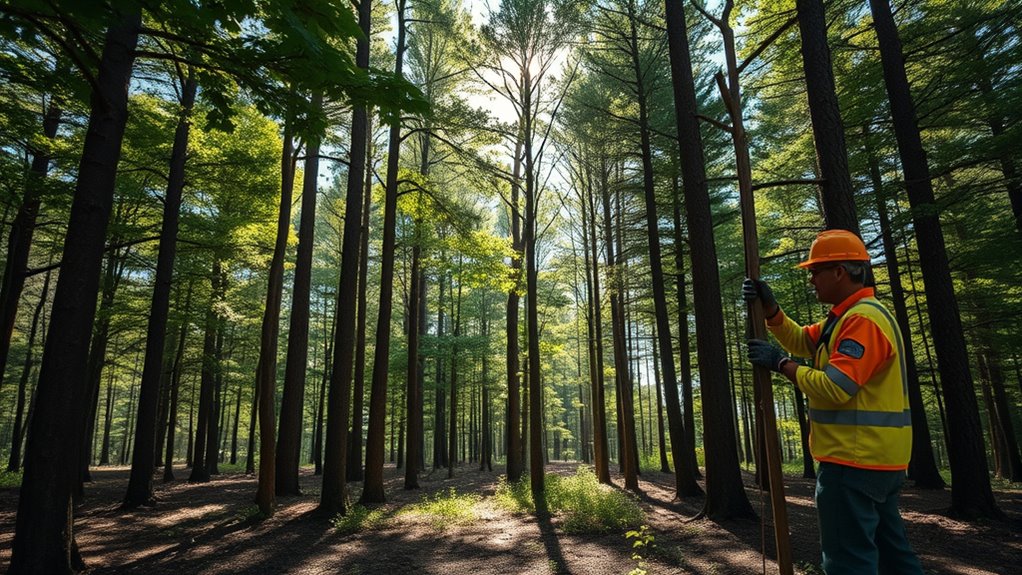
Managing competition and overstory density is essential for promoting healthy, vigorous growth in your timber stand. Proper thinning practices help control overstory dynamics, ensuring trees receive enough sunlight, nutrients, and space. To optimize your stand, consider these steps:
- Assess the current overstory density to identify overly crowded areas.
- Remove suppressed or unhealthy trees to reduce competition.
- Thin dominant and codominant trees gradually to maintain a balanced canopy.
- Monitor the stand regularly, adjusting thinning intensity as trees grow and overstory dynamics change.
Controlling Unwanted Vegetation
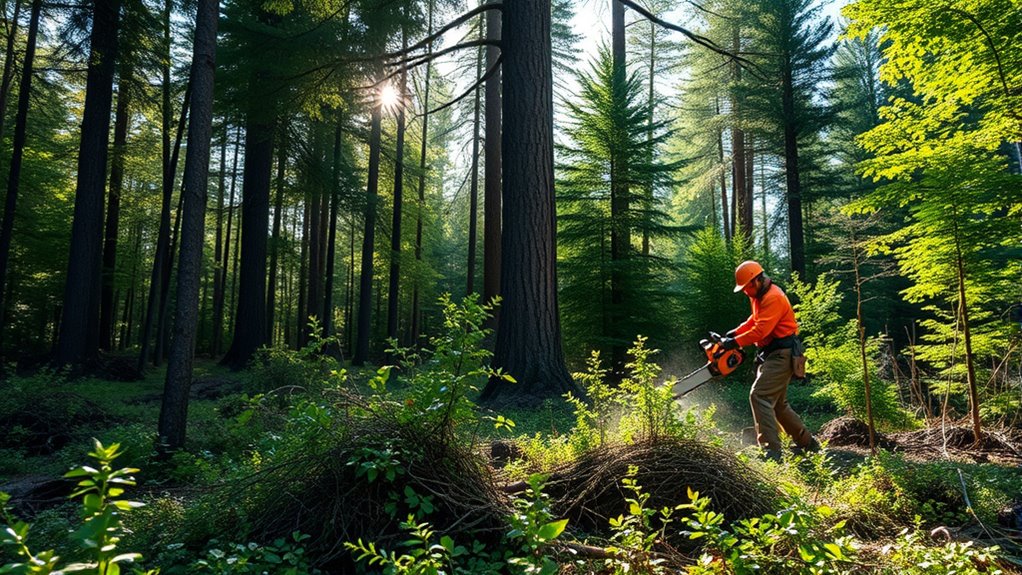
Controlling unwanted vegetation is a crucial part of maintaining a healthy timber stand, as invasive species and aggressive undergrowth can compete with your trees for nutrients, water, and sunlight. To effectively manage this, herbicide application is a common method. Carefully identify invasive plants and apply the appropriate herbicide to target them without harming your desirable trees. Timing is critical; applying herbicides during active growth stages ensures better control. Regular monitoring helps catch invasive species early before they establish deep roots or spread widely. Removing or controlling unwanted vegetation reduces competition, allowing your trees to grow stronger and produce higher-quality timber. Consistent management and proper herbicide use are essential to keep invasive species at bay and maintain a healthy, productive stand. Utilizing proper identification and ratings can help choose the most effective herbicides and strategies for your specific situation. Additionally, understanding spiritual energy and its influence can promote a mindful approach to land management, fostering harmony between your practices and the natural environment. Recognizing the role of ecosystems in maintaining land health can further enhance sustainable management practices. Incorporating sustainable practices like native plant preservation can also improve long-term land resilience and ecological balance.
Implementing TSI Techniques and Practices

Implementing Timber Stand Improvement (TSI) techniques involves a strategic combination of practices designed to enhance stand productivity and health. To do this effectively, you should:
Implementing TSI enhances stand health through pest management, soil improvement, and selective thinning for better growth.
- Conduct pest management by removing infested or unhealthy trees to prevent disease spread. Incorporating pest management strategies helps protect your stand from insects and diseases that can diminish growth and vitality.
- Enhance soil quality through fertilization or organic amendments to promote vigorous growth.
- Selectively thin the stand to reduce competition and increase light penetration.
- Apply soil enhancement practices like aeration or mulching to improve root development.
- Consider the role of water parks in providing relaxation and outdoor recreation for forest workers and landowners after implementing TSI practices.
These steps help create a healthier environment for your trees, boosting growth rates and resilience. Proper pest management minimizes damage from insects and diseases, while soil enhancement ensures trees have the nutrients they need. Combining these practices makes your TSI efforts more effective, leading to a productive, sustainable stand.
Monitoring and Evaluating Stand Improvement Progress
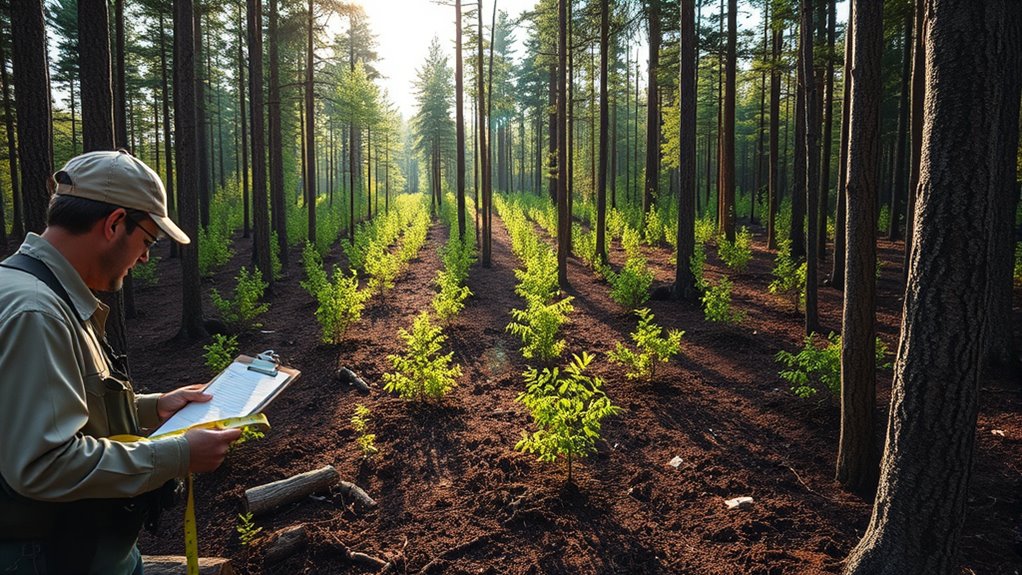
Monitoring and evaluating your stand’s improvement progress is essential to guarantee your efforts are effective and on track. Regular soil testing helps you assess nutrient levels and soil health, guiding necessary adjustments to fertilization or other treatments. Keep an eye on pest management by inspecting trees for signs of pests or disease, enabling early intervention before problems escalate. Track growth rates, tree vigor, and species diversity to measure improvements over time. Use this data to compare current conditions with your initial baseline, ensuring your TSI practices are working. Adjust your management strategies based on your findings, whether that means modifying thinning plans or enhancing soil fertility. Consistent monitoring ensures your timber stand remains healthy and productive, maximizing your investment.
Frequently Asked Questions
How Often Should TSI Activities Be Performed?
You should perform TSI activities regularly, typically every 5 to 10 years, depending on your forest’s specific needs. This interval helps maintain timber health and enhances forest resilience by removing competing or unhealthy trees. Consistent TSI guarantees your stand stays vigorous, promotes growth, and reduces risks like pests or disease. By staying proactive, you support a thriving, resilient forest that sustains your management goals.
What Equipment Is Needed for Effective TSI?
Thinking you can TSI effectively with just a pocket knife? Think again. For effective Timber Stand Improvement, you’ll need reliable equipment like tree marking tools for clear identification and sharp saws or clippers for precise cuts. Don’t forget to maintain your gear—dull blades are as useless as a forest without trees. Proper equipment ensures safe, efficient work, helping your stand thrive rather than just survive.
Can TSI Be Done on Small Private Properties?
You can definitely perform Timber Stand Improvement (TSI) on small private properties. TSI helps improve timber health and enhances forest aesthetics, making your land more productive and attractive. With proper planning, limited equipment, and basic knowledge, you can selectively remove undesirable trees and promote healthier growth. Small property owners often find TSI a rewarding way to manage their land, ensuring it remains sustainable and visually appealing for years to come.
What Are Common Mistakes to Avoid in TSI?
Imagine walking through your forest, spotting trees that stand out like sore thumbs. In TSI, common mistakes include neglecting selective thinning, which can overcrowd your stand, and ignoring disease management, allowing pests or fungi to spread. You might also over-thin, leaving too few trees, or under-thin, resulting in competition. Avoid these errors by planning carefully, balancing tree removal, and monitoring health to guarantee a lush, healthy stand.
How Does TSI Impact Wildlife Habitat?
Timber Stand Improvement boosts wildlife habitat by creating better conditions for diverse species. You can enhance habitat by designing wildlife corridors, allowing animals to move safely between areas. TSI also promotes habitat enhancement by opening the canopy and diversifying plant life, which attracts various wildlife. Your efforts help improve food sources, shelter, and migration pathways, ultimately fostering healthier ecosystems and supporting a broader range of native species.
Conclusion
Think of timber stand improvement as tending a garden—your careful pruning and nurturing clear the way for healthy growth. Each decision you make, from selecting desirable trees to controlling competition, acts like watering and trimming, shaping a thriving forest. By monitoring progress, you’re tending the roots of your stand’s future. With patience and attention, you’ll cultivate a resilient, flourishing woodland—your thriving forest, a symbol of your dedication and care.
